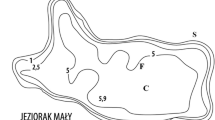Abstract
The accelerated nutrient enrichment of Dal Lake, Kashmir has augmented the production of aquatic vegetation to the point where many recreational activities have been severely impaired. For providing relief from nuisance conditions mechanical deweeding was introduced in the lake in 1986. The present study assesses the impact of large scale vegetation removal on water quality, plankton population, macrophyte and fish. The concentrations of electrical conductivity, dissolved oxygen, total phosphorus and nitratenitrogen changed significantly immediately after deweeding. Phytoplankton species which increased after deweeding includeAmphora ovalis, Cymbella cistula, Cosmarium sp.: also rotifers increased (Anuraeopsis fissa, Brachionus calyciflorus andMonostyla bulla).
Similar content being viewed by others
References
A.P.H.A., 1970. Standard methods for the examination of waters, sewage and industrial wastes, New York, 174 pp.
Breck, J. E., R. T. Prentki & O. L. Loucks, 1979. Aquatic plants, lake management and ecosystem consequences of lake harvesting. Inst. Envir. Studies, Madison, WI, 435 pp.
Carpenter, S. R., 1976. Some environmental impacts of mechanical harvesting of nuisance submerged vascular plants. M.S. thesis. Univ. of Wisconsin, Madison, 95 pp.
Carpenter, S. R., A. Gasith, 1975. Mechanical cutting of submerged macrophytes: immediate effects on littoral water chemistry and metabolism. Water Research. 12: 55–57.
Enex, 1978. Pollution of Dal lake. Enex of New Zealand Inc, 140 pp.
Gasith, A., 1975. Tripton sedimentation in eutrophic lakes — simple corrections for the resuspended matter. Verh. int. Ver. Limnol. 19: 166–122.
Golterman, H. L. & R. S. Clymo, 1969. Methods for chemical analysis of fresh water. IBP Hand Book No. 5. Blackwell Scientific Publication, Oxford, 172 pp.
Mackereth, F. J. M., 1963. Water analysis for Limnologists. Fresh. Wat. Biol. Assoc. 21: 1–70.
Neel, J. K., S. A. Peterson & W. L. Smith, 1973. Weed harvest and lake nutrient dynamics. EPA-660/3-73-001.
Peterson, S. A., W. L. Smith & K. W. Malueg, 1974. Full scale harvest of aquatic plants: nutrient removal from a eutrophic lake. J. Wat. Pollut. Cont. Fed. 46: 697–707.
Wile, I. & G. Hitchin, 1977. An assessment of the practical and environmental implications of mechanical harvesting of aquatic vegetation in Southern Chemung Lake. Ontario Ministry of the Environment, Canada, 180 pp.
Young, W. C., H. H. Hannan & J. W. Tatune, 1972. The physicochemical limnology of a stretch of the Guadalupa River Taxas, with main stream impoundments. Hydrobiologia 40: 297–319.
Zutshi, D. P. & K. K. Vass, 1982. Limnological studies on Dal lake, Srinagar III. Biological features. Proc. Indian natn. Sci. Acad. 48: 234–241.
Author information
Authors and Affiliations
Rights and permissions
About this article
Cite this article
Zutshi, D.P., Ticku, A. Impact of mechanical deweeding on Dal Lake ecosystem. Hydrobiologia 200, 419–426 (1990). https://doi.org/10.1007/BF02530359
Issue Date:
DOI: https://doi.org/10.1007/BF02530359




